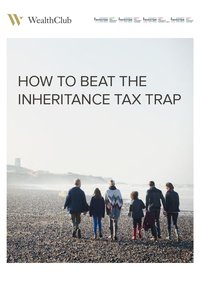HMRC raises a record £7.1bn in inheritance tax – how could you protect your wealth?
Archived article
Archived article: please remember tax and investment rules and circumstances can change over time. This article reflects our views at the time of publication.
HMRC raised a record £7.1 billion in inheritance tax (IHT) receipts in the year to March 2023, figures released on 25 April show. That is £1 billion more than in the same period last year.
The upward trend is expected to continue. With the freeze on inheritance tax nil-rate bands until 2028, rising house prices and inflation, IHT receipts are forecast to reach an all-time high of £8.4 billion in 2027/28. Meanwhile, more and more families are being dragged over the threshold at which the tax becomes due.
This article looks at three ways you could potentially save loved ones this punitive tax on the wealth you bequeath them – wealth you might have already paid tax on in your lifetime.
Inheritance tax in a nutshell
Your loved ones, other than spouse or civil partner, could typically face a 40% inheritance tax on assets you bequeath them over an allowed threshold.
If you are a single homeowner passing on assets to direct descendants, the tax-free allowance is up to £500,000 (£1 million if you’re married or in a civil partnership). This includes your £325,000 nil-rate band, plus £175,000 main residence nil-rate band.
The residence nil-rate band is reduced £1 for every £2 for estates worth over £2 million; if your estate is worth £2.35 million you might lose it altogether.
Important: The information on this website is for experienced investors. It is not a personal recommendation to invest. If you’re unsure, please seek advice. Investments are for the long term. They are high risk and illiquid and can fall as well as rise in value: you could lose all the money you invest.
How might you pass on more of your wealth?
There are several options. One that could be of interest to experienced investors is investing in companies that qualify for Business Property Relief (BPR). Unlike gifts or trusts, the investment potentially becomes IHT free after two years (instead of seven) and you retain ownership and control of the money, so could make withdrawals if needed.
On the flipside, BPR-qualifying investments are high risk – you could lose your capital. These investments must remain qualifying and also still be held on death. Remember, tax rules can change and benefits depend on circumstances.
What is BPR and why the IHT relief?
Business Property Relief was first introduced in 1976 to allow family businesses to be passed down through generations free of IHT. Its scope later widened, making BPR available for a range of assets in which you can invest – this includes shares in certain private and AIM-quoted companies, as well as investments in commercial forestry.
Here’s how experienced investors may invest and benefit from BPR.
 1. Making your ISAs IHT-free: AIM ISAs
1. Making your ISAs IHT-free: AIM ISAs
As you may know, cash ISAs and Stocks & Shares ISAs offer tax-free income and growth during your lifetime – but could be subject to 40% inheritance tax when you die.
AIM ISAs invest in AIM-quoted companies that should qualify for BPR and should therefore be IHT free after two years.
The ISA allowance for new subscriptions is £20,000 a year, but you can transfer larger amounts from existing ISAs into an AIM ISA portfolio. Once invested, any growth and income should be tax free.
A typical portfolio will be diversified across 20-40 companies, usually in different sectors. The fund manager will aim to deliver some growth whilst trying to mitigate volatility. AIM portfolios are likely to be more volatile than conventional Stocks & Shares ISAs.
 2. Investing in inheritance tax (IHT) portfolios
2. Investing in inheritance tax (IHT) portfolios
An IHT portfolio is a managed portfolio of companies that qualify for BPR. The managers tend to look for companies they believe are lower risk and with relatively predictable cash flows. Their goal is typically to preserve your capital so you can pass on as much as possible and spare your family a 40% IHT bill in the process.
That said, IHT portfolios invest in small companies – these are by nature more volatile and illiquid than larger companies and thus much higher risk. Neither your capital nor the tax savings are guaranteed.
 3. Investing in forestry – if you are eligible
3. Investing in forestry – if you are eligible
Under BPR, investing in UK commercial forests could provide IHT relief after two years. An additional benefit is that no income tax or capital gains tax is applied on the value of the timber.
Investing in forestry is a long-term commitment – possibly 10 years or more – and a forest is by its nature a very illiquid asset. If you’re comfortable with that, it can have significant tax benefits and once established requires comparatively little upkeep. A popular way to invest is through a forestry fund.
Because of the way forestry funds are structured, they are normally only open to very experienced or professional investors. Investors wishing to view specific fund information must first successfully complete a questionnaire designed to assess investment knowledge and experience – check to see if you qualify.
Other IHT-free options: EIS and SEIS
Other than BPR-qualifying investments, if you invest in EIS and SEIS it is worth remembering these should qualify for IHT relief after two years of investment – part of the generous tax package they offer.
EIS and SEIS should not be used exclusively as an IHT planning tool. Like IHT portfolios, EIS and SEIS are high risk and you could get back less than you invest.
What to do next?
Having been prudent enough to accrue wealth during your lifetime, you may not wish to have the taxman take 40p of every £1 you’ve worked hard to save over the years. Read our free guide to explore some of the options.
If you have any questions on the guide or another investment matter, please get in touch.
You can email us or call us on 0117 929 0511. We're open from 9am to 5.30pm Monday to Friday.
Wealth Club aims to make it easier for experienced investors to find information on – and apply for – investments. You should base your investment decision on the offer documents and ensure you have read and fully understand them before investing. The information on this webpage is a marketing communication. It is not advice or a personal or research recommendation to buy any of the investments mentioned, nor does it include any opinion as to the present or future value or price of these investments. It does not satisfy legal requirements promoting investment research independence and is thus not subject to prohibitions on dealing ahead of its dissemination.
Inheritance Tax portfolios
See our IHT portfolios section for more information on how to beat the IHT trap
Read more about Inheritance Tax portfolios
